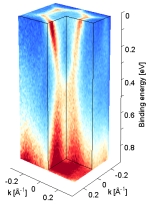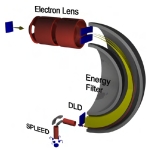Research Group of Prof. Dr. Claus M. Schneider

Laboratory experiments
The principle of operation of modern spintronic devices, such as magnetic tunnel junctions, is based on specific properties of electronic band dispersions, which exist in reciprocal space. High resolution angle-resolved photoemission (ARPES) has become the method of choice to probe the electronic structure of any new material.
Our laboratory based ARPES system [1] is equipped with a Scienta SES200 angle-resolving hemispherical analyzer, several gas discharge photon sources capable of producing 8.3, 10.0, 11.6, 21.2 and 40.8 eV photons, and a helium cooled cryostat capable of cooling the sample down to 15K.
Since photoemission is a surface sensitive technique all experiments are performed under ultra-high vacuum (UHV) conditions. Surface preparation techniques such as cleaving, sputtering, and annealing are all available under UHV. Ultra thin epitaxial films can be grown by molecular beam epitaxy (MBE), and the system is equipped with other standard equipment such as a low energy electron diffraction (LEED) system, an Auger-spectrometer, a mass spectrometer, a quartz balance thickness monitor etc.
The figure shows the three dimensional impression of the electronic structure of Bi2Te3 measured with 21.2 eV photons and the sample temperature kept at 15K [2].
We are currently building another system, based on a modern hemispherical analyzer, and equipped with two detectors operating simultaneously, one capable of ARPES, and the other one being able to probe the spin of the electrons.
[1] S. Suga, A. Sekiyama, G. Funabashi, J. Yamaguchi, M. Kimura, M. Tsujibayashi, T. Uyama, H. Sugiyama, Y. Tomida, G. Kuwahara, S. Kitayama, K. Fukushima, K. Kimura, T. Yokoi, K. Murakami, H. Fujiwara, Y. Saitoh, L. Plucinski, and C. M. Schneider, “High resolution, low h nu photoelectron spectroscopy with the use of a microwave excited rare gas lamp and ionic crystal filters”, Rev. Sci. Instrum. 81, 105111 (2010).
[2] L. Plucinski, G. Mussler, J. Krumrain, A. Herdt, S. Suga, D. Grützmacher, and C. M. Schneider, "Robust surface electronic properties of topological insulators: Bi2Te3 films grown by molecular beam epitaxy", Appl. Phys. Lett. 98, 222503 (2011).

XPS experiments at DELTA in Dortmund
We run a beamline and an experimental endstation at the synchtrotron light source DELTA of the TU Dortmund. The system is optimized for angle and spin-resolved photoemission experiments in the ultraviolet (UV) and x-ray regime. Here we investigate magnetic multilayer structures and their interfaces and surfaces.
An undulator at the electron storage ring delivers the radiation that ís needed for our experiments in an energy range between 10 eV and 400 eV with highest intensity for low energies. The radiation is monochromatized by a plane-mirror plane-grating monochromator and guided to the endstation. Thus, we can make use of radiation with a high intensity over a large energy range.
The endstation is equipped with a hemispherical electron analyzer to which two different detectors are connected [3]. ARPES experiments can be conducted with the angle-resolving 2D delay-line detector in order to investigate the electronic bandstructure. The other detector is a SPLEED system for spin-resolved photoemission experiments.
The samples under investigation are prepared in a second UHV chamber that is connected to the experimental station in a way that the samples can be transfered under UHV conditions. In order to clean the surfaces of ex-situ prepared samples and also to manufacture new samples the preparation chamber is equipped with different evaporator and sputter systems. Also a LEED and an Auger system are built in.
[3] L. Plucinski, A. Oelsner, F. Matthes, and C.M. Schneider, "A hemispherical photoelectron spectrometer with 2-dimensional delay-line detector and integrated spin-polarization analysis", J. Electron. Spectrosc. Relat. Phenom. 181, 215-219 (2010).
Selected publications
V. Feyer, M. Graus, P. Nigge, G. Zamborlini, R. G. Acres, A. Schöll, F. T. Reinert, and C. M. Schneider, "The geometric and electronic structure of TCNQ and TCNQ+Mn on Ag(001) and Cu(001) surfaces", J. Electron. Spectrosc. Relat. Phenom.204, 125 (2015).
M. L. Hoppe, S. Döring, M. Gorgoi, S. Cramm, and M. Müller, "Enhanced ferrimagnetism in auxetic NiFe2O4 in the crossover to the ultrathin-film limit" ,Phys. Rev. B 91, 054418 (2015).
Y. Aoki, C.Wiemann, V. Feyer, H.-S. Kim, C. M. Schneider, H. Ill-Yoo, and M. Martin, "Bulk mixed ion electron conduction in amorphous gallium oxide causes memristive behaviour", Nat. comm. 5, 3473 (2014).
M. Patt, C. Wiemann, N. B. Weber, M. Escher, A. V. Gloskovskiǐ, W. Drube, M. Merkel, and C. M. Schneider, "Bulk sensitive hard x-ray photoemission electron microscopy", Rev. Sci. Instrum. 85, 113704 (2014).
C. Caspers, A. Gloskovskii, W. Drube,c. M. Schneider, and M. Müller, "Conductive yttria-stabilized zirconia as an epitaxial template for oxide heterostructures", J. Appl. Phys. 115, 17C111 (2014).
D. Legut, M. F. Tesch, H.-Ch. Mertins, M. C. Gilbert, C. Jansing, D. E. Bürgler, C. M. Schneider, A. Gaupp, J. Hamrle, and P. M. Oppeneer, "Influence of the crystal structure of thin Co films on X-ray magnetic linear dichroism: comparison of ab initio theory and reflectometry experiments", J. Appl. Phys. 115, 17E132 (2014).
V. Feyer, M. Graus, P. Nigge, M. Wießner, R. G. Acres, C. Wiemann, C. M. Schneider, A. Schöll, and F. Reinert, "Adsorption geometry and electronic structure of iron phthalocyanine on Ag surfaces: a LEED and photoelectron momentum mapping study", Surf. Sci. 621, 64 (2014).
H.-C. Mertins, D. Legut, C. Jansing, M. Gilbert, A. Gaupp, P. M. Oppeneer, D. E. Burgler, C. M. Schneider, and U. Berges, "Detection of the Magnetocrystalline Anisotropy in X-Ray Magnetic Linear Dichroism Reflection Spectra Across the Fe 3p and 2p Edges", IEEE Transactions on Magnetics 50, 11 (2014).
D. Gottlob, T. Jansen, M. Hoppe, D. E. Bürgler, and C. M. Schneider, "Epitaxial Cu(001) films grown on a Cr/Ag/Fe/GaAs(001) buffer system", Thin Solid Films 562, 250 (2014).
M. F. Tesch, D. Legut, H.-Ch. Mertins, M. C. Gilbert, C. Jansing, J. Hamrle, J. Rusz, P. M. Oppeneer, D. E. Bürgler, C. M. Schneider, A. Gaupp, and U. Berges, "Magnetocrystalline anisotropy in x-ray magnetic linear dichroism at the 3p edges of crystalline Fe thin films", Phys. Rev. B 89, 140404 (2014).
S. Khan, F. Bahnsen, S. Cramm, S. Döring, J. Grewe, M. Höner, H. Huck, M. Huck, R. Molo, L. Plucinski, A. Schick, C. M. Schneider, and P. Ungelenk, "Generation of Ultrashort and Coherent Synchrotron Radiation Pulses at DELTA", Synchrotron Radiation News 26, 25 (2013).
A. Herdt, L. Plucinski, G. Bihlmayer, G. Mussler, S. Döring, J. Krumrain, D. Grützmacher, S. Blügel, and C. M. Schneider, “Spin-polarization limit in Bi2Te3 Dirac cone studied by angle- and spin-resolved photoemission experiments and ab initio calculations”, Phys. Rev. B 87, 035127 (2013).
L. Plucinski, A. Herdt, S. Fahrendorf, G. Bihlmayer, G. Mussler, S. Döring, J. Kampmeier, F. Matthes, D. E. Bürgler, D. Grützmacher, S. Blügel, and C. M. Schneider, “Electronic structure, surface morphology, and topologically protected surface states of Sb2Te3 thin films grown on Si(111)”, J. Appl. Phys. 113, 053706 (2013).
